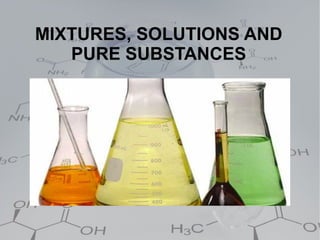
Mixtures solutions and pure substances
- 1. MIXTURES, SOLUTIONS AND PURE SUBSTANCES
- 2. Matter and its appearance According to its appearance, there are two kinds of material systems: Homogeneus systems: they have the same properties and compositions in all different parts of them. Heterogeneus systems: different parts with different properties can be found in them.
- 5. Heterogeneus Mixtures Systems with several different substances that can be distinguished: Oil and water. Granite is a rock that has three different substances: quartz, mica and felspar. Blood: using a microscope we can see a liquid (plasma) and different kinds of cells. Smoke: has solid particles in a gas (air).
- 6. Heterogeneous Mixtures How to separe their components: – If the components are a solid and a liquid, we can separe them by filtering. • E. g.: water and sand
- 7. Heterogeneous Mixtures How to separe their components: – Decantation: This method uses the different densities of the components to separe them: • (E.g.: oil and water)
- 8. Homogeneous Systems There are two kinds of homogeneous systems: Pure substances: • They have an only component • They have constant composition and properties. Solutions: • They have several components. • Their composition can be changed
- 9. Solutions A solution has, at least, two components: Solute: It is the component that is present in a lower quantity in the solution. Solvent: It is the component that is present in excess. Its state never changes when the solution is being formed A simple sample: salty water: There is much more water than salt Water is a liquid and the solution too. SOLUTE = SALT and SOLVENT = WATER
- 10. Solutions They are not always liquids
- 11. Solutions There three kinds of solutions: Solvent + a small amount of solute = diluid solution. Solvent + a large amount of solute = concentrate solution. The quantity of solute that can be dissolved has a limit (solubility). In this case we have a satured solution. If we try to dissolve more solute in a satured solution, the extra quantity of solute will fall onto the botton of the container. (precipitation)
- 12. Solutions Concentration of a solution: – Expresses, in a numeric way, the quantity of soluto un a specific quantity of solution. amountofsoluto concentration= amountofsolution There are many ways of express it, depending of the unit we use. We are going to study three of them.
- 13. Solutions Concentration: grams per liter of solution. massofsoluto ( g ) concentration ( g / L )= Volumenofsolution Sample: we put 20 grams of sugar in a 500-mililiters flask and fill it in with water. In the flask, there are: 20 g of soluto (sugar) Soluto and solvent with a total volume of 500 mL = 0,5 L concentration (g/L) = 20 g / 0,5 L = 40 g/L
- 14. Solutions Concentration: percentage in mass massofsoluto concentration ( mass )= · 100 massofsolution Sample: we add 25 grams of salt into a flask that contains 100 grams of water. In the flask, there are: 25 g of soluto (salt) 100 g + 25 g = 125 g of solution (salt + water) % mass = (25 g / 125 g) · 100 = 20 % in mass
- 15. Solutions Concentration: percentage in volume volumeofsoluto concentration ( volume )= · 100 volumeofsolution Sample: we mixure 20 mililiters of alcohol and 130 mililiters of water: We have: 20 mL of alcohol (alcohol) 130 mL + 20 mL = 150 mL of solution (alcohol + water) % mass = (20 mL / 150 mL) · 100 = 13.3 % in volume
- 16. Solutions How to separate its components: – Evaporation and crystallization: a liquid evaporates at room temperature, but a solid doesn't.
- 17. Solutions How to separate its components: – Distillation: this method is useful to separate: • Liquids whose boiling points are different enough • Liquids and solids
- 18. Pure Substances Pure substances: They have a constant composition. They can't be separated in simpler substances using physical methods. There are two different kinds of pure substances: Chemical compounds: pure substances that can be separated in others using chemical methods. Elements: pure substances that can't be separated in others
- 19. Compound Pure substance composed of two or more different elements joined by chemical bonds. Made of elements in a specific ratio that is always the same Has a chemical formula Can only be separated by chemical means, not physically There are millions of different compounds in nature
- 20. Compound ¿Compound or Mixture?
- 21. Element It is the simplest kind of matter. Has a chemical symbol. Can't be separated in others substances There are only about one hundred elements in natures. All of them are in the Periodic Table
- 22. Four kinds of matter
- 23. Four kinds of matter
- 24. Four kinds of matter
